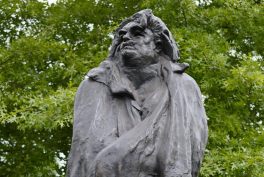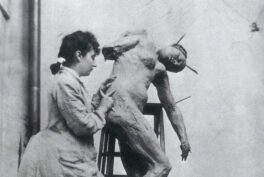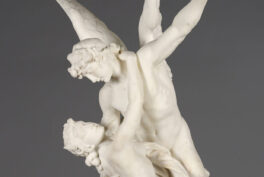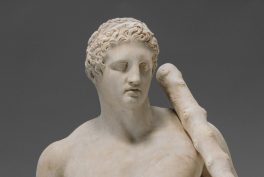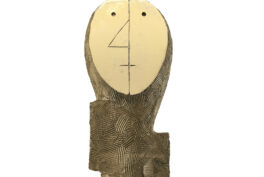Auguste Rodin, born in Paris in 1840, initially faced rejection from traditional art institutions. However, eventually, his determination and unique way of thinking earned him global recognition. With masterpieces such as The Thinker or The Kiss, Rodin is still regarded as one of the most important modern artists, who broke away from the academic canon pushing the sculpture to new ways of expression.
Several prominent authors have analyzed Auguste Rodin’s work offering diverse perspectives on his art and its impact. Rainer Maria Rilke, in his poetic reflections, explored the emotional depth of the artist’s oeuvre. Albert Elsen, a key expert on Rodin, emphasized the innovative aspects of his techniques. Meanwhile, Rosalind Krauss and Catherine Lamper, highlighted his influence on modern and contemporary art.
1. Adam
The Three Shades is a powerful sculpture inspired by Dante’s Divine Comedy. These figures, representing the souls of the damned, were created to stand atop The Gates of Hell, pointing toward the haunting message, “Abandon hope, all ye who enter here.” Rodin used three identical figures arranged in a circle, their dramatic poses evoking torment and despair. The figures’ distorted necks and shoulders form a striking horizontal line, adding a sense of unity and tension. This blend of naturalist approach and emotional depth highlights Auguste Rodin’s unmatched ability to create sculptures that are both captivating and unsettling.
3. The Age of Bronze
The Age of Bronze, first exhibited in 1877, marked a major breakthrough in the artist’s career. Moving away from traditional academic ideals, he created a figure that felt alive, with closed eyes and a slightly open mouth, as if caught in the moment of awakening.
Inspired by Michelangelo’s Dying Slave and classical Greek art, Rodin gave the figure a delicate contrapposto, with most of its weight resting on one leg. The sculpture’s naturalism led some critics to accuse Rodin of casting directly from a live model, a controversy that only boosted his fame. Rodin’s focus on inviting viewers to walk around and fully engage with the work showcased his creative approach to capturing life and movement.
4. The Burghers of Calais
Another Auguste Rodin sculpture, The Burghers of Calais, tells a powerful story of sacrifice and courage. In 1885, the French city of Calais commissioned Rodin to honor six citizens who offered their lives to save their city during the Hundred Years’ War (you can read more about this story here). The result was breathtaking.
Each figure wears a simple tunic and a rope around its neck, symbolizing their readiness to face death. Their unique expressions and stances, from despair to resignation, reveal their personal struggles. They stand together but avoid eye contact, which emphasizes their isolation. Bare feet and slumped shoulders, emphasizing their vulnerability, make their march feel deeply human. Completed in 1889, the monument was installed in 1895 in a way that did not follow Rodin’s original vision of placing it at ground level, which surely would create even greater impact.
5. Despair
Despair reflects Rodin’s deep exploration of human sorrow, combining dynamic movement with emotional intensity. Originally created for The Gates of Hell, the sculpture portrays a woman seated on a rock, as she tries to stretch her leg, capturing an endless cycle of inner struggle. Unlike usual expressive depictions of grief, where the face reflects the suffering, this figure conveys sorrow through body tension and emotional confinement. Its compact, streamlined form received widespread praise, inspiring later works like Aristide Maillol’s The Mediterranean. Over time, Despair became widely reproduced, solidifying its role as a timeless meditation on the human condition.
6. Eternal Springtime
Eternal Springtime captures the intense passion and tenderness of romantic love. The woman, arching her torso in surrender, accepts her partner’s kiss with graceful vulnerability. In this piece, Rodin drew on earlier representations of mythological theme of Cupid and Psyche and reinterpreted this timeless story in this work. The figures’ embrace, filled with movement and emotion, reflects Rodin’s genius for depicting raw human sensuality, making this sculpture a timeless celebration of love.
7. The Walking Man
The Walking Man is a powerful study of movement and form. Using parts from his earlier works, including studies for Saint John the Baptist, Rodin assembled the figure in the late 1890s, intentionally leaving it headless and armless. This bold choice shifted focus to the body’s dynamic, with its strong legs, arched torso, and wide stance capturing the energy of a man mid-stride. The rough, textured surface amplifies the motion, as light and shadow play across its uneven contours. Although, when exhibited, it initially received mixed reviews from the critics, Rodin’s innovative approach successfully conveyed the power and movement while breaking away from the full-figured canon, making it a revolutionary piece in modern sculpture.
8. Christ and the Magdalen
Christ and the Magdalen stands out as one of Auguste Rodin’s few religiously inspired sculptures. The piece depicts a sorrowful Magdalen clinging to the fragile body of Christ, whose heavy head tilts sideways in suffering. Originally, the Magdalen figure was designed for The Gates of Hell but was later adapted into this deeply moving composition. The marble version, created around 1905 for Baron Thyssen, heightens the emotional impact through the stark contrast between the smooth bodies and the roughly-finished background.
As Rainer Maria Rilke noted, the visible contrast between the two figures—with their heads tilted in different directions, one with arms stretched, the other bended—evokes an overwhelming grief, showcasing Rodin’s mastery in conveying human emotion through sculpture.
9. Meditation
Meditation, later renamed The Inner Voice, reflects Auguste Rodin’s evolving approach to form and emotion in sculpture. The figure was reworked into the Monument to Victor Hugo as one of the muses. Rodin removed her arms and part of her legs to fit the composition. Initially, the public struggled to accept the unfinished look of the sculpture. However, it was praised by Rainer Maria Rilke, who described it as a complete artwork that needs no additions. Over time, this piece came to symbolize Rodin’s shift towards a more abstract style, characterized by simplicity of form and raw emotions.
10. The Gates of Hell
The Gates of Hell stands as one of Auguste Rodin’s most ambitious sculptures, consisting of over 200 figures some of which shaped his artistic legacy. Originally commissioned in 1880 for a planned Decorative Arts Museum that eventually was never built, the project became a lifelong endeavor. Despite planning to unveil it at the 1889 Exposition Universelle, Rodin left it incomplete, showcasing fragments in 1900 at his solo exhibition in Paris. Over time, The Gates transformed into a stage for his evolving ideas, with individual figures like The Thinker gaining fame as individual composition.
Rodin passed away before the eventual bronze casting of The Gates of Hell in 1917. The original plaster of the work is on view at the Musée d’Orsay in Paris.


